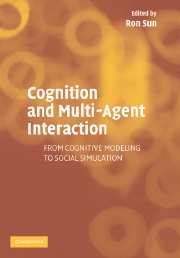Book contents
- Frontmatter
- Contents
- List of Contributors
- Preface
- PART 1 INTRODUCTION
- PART 2 OVERVIEWS OF COGNITIVE ARCHITECTURES
- PART 3 MODELING AND SIMULATING COGNITIVE AND SOCIAL PROCESSES
- 5 Cognitive Architectures, Game Playing, And Human Evolution
- 6 Simulating A Simple Case Of Organizational Decision Making
- 7 Cognitive Modeling of Social Behaviors
- 8 Cognitive Agents Interacting in Real and Virtual Worlds
- 9 Modeling Social Emotions and Social Attributions
- 10 Communicating and Collaborating with Robotic Agents
- 11 Behavior-Based Methods for Modeling and Structuring Control of Social Robots
- 12 Evolution of a Teamwork Model
- 13 Sociality in Embodied Neural Agents
- 14 Cognitive Architecture and Contents for Social Structures and Interactions
- PART 4 A SYMPOSIUM
- Index
11 - Behavior-Based Methods for Modeling and Structuring Control of Social Robots
Published online by Cambridge University Press: 15 December 2009
- Frontmatter
- Contents
- List of Contributors
- Preface
- PART 1 INTRODUCTION
- PART 2 OVERVIEWS OF COGNITIVE ARCHITECTURES
- PART 3 MODELING AND SIMULATING COGNITIVE AND SOCIAL PROCESSES
- 5 Cognitive Architectures, Game Playing, And Human Evolution
- 6 Simulating A Simple Case Of Organizational Decision Making
- 7 Cognitive Modeling of Social Behaviors
- 8 Cognitive Agents Interacting in Real and Virtual Worlds
- 9 Modeling Social Emotions and Social Attributions
- 10 Communicating and Collaborating with Robotic Agents
- 11 Behavior-Based Methods for Modeling and Structuring Control of Social Robots
- 12 Evolution of a Teamwork Model
- 13 Sociality in Embodied Neural Agents
- 14 Cognitive Architecture and Contents for Social Structures and Interactions
- PART 4 A SYMPOSIUM
- Index
Summary
INTRODUCTION
People and robots are embodied within and act on the physical world. This chapter discusses an action-centered methodology for designing and understanding control, perception, representation, adaptation, and learning in physical robots, inspired by evidence from social biological systems. A working robotic implementation based on a biologically plausible model provides strong support for that model. Primarily it provides a demonstration of classes of behavior for which the underlying theory is sufficient. In addition to ensuring that the underlying theory has been specified with algorithmic rigor, it also assures that the model is effective even in the presence of noise and various other effects of a dynamic environment. Shortcomings of the implementation may highlight concrete issues on which a later and further refined theory may focus, thereby playing an important role in the hypothesize-test-rehypothesize cycle. Robotic systems are one of the few ways to provide a complete end-to-end validation of social theories that deal with self-referential notions and require validation.
A central postulate of the action-centered methodology is that intelligent behavior in an embodied system is fundamentally structured by the actions the system is capable of carrying out. In societal systems the individuals' social behavior, including communicative and interaction actions, similarly structures the large-scale behavior. This is supported by neuroscience evidence and has a key impact on the way human activity and robot control are understood and modeled.
The belief that reasoning agents/systems should be built upon actioncentered characteristics such as the physical dynamics and task constraints toward effective cognitive capabilities embodies what is known in the AI community as a bottom-up philosophy, and contrasts with other so-called top-down views.
- Type
- Chapter
- Information
- Cognition and Multi-Agent InteractionFrom Cognitive Modeling to Social Simulation, pp. 279 - 306Publisher: Cambridge University PressPrint publication year: 2005
- 5
- Cited by



